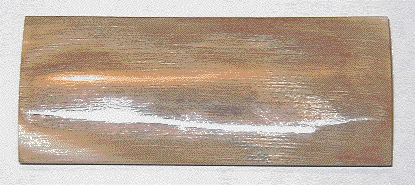MATERIAL
|
DESCRIPTION
|
African Blackwood
|
An exceptionally dense, very hard wood that works well and needs no finish. It is a rich dark brown with contrasting tan colors.
|
Arizona Ironwood
(Sometimes called Desert Ironwood)
|
A rich golden brown wood with strong chocolate brown to black figure. It is very heavy, hard, oily, and finishes to a smooth satin finish. It makes a beautiful presentation knife when paired with gold or brass hardware. The best grades, having beautiful marking and color, come from deep in the Mexican Sonora desert and are becoming very scarce. Supplies are dwindling and prices increasing. The presentation grades are the most beautiful of all woods.
|
Bloodwood
|
A brilliantly colored wood. It is a rich deep red with undertones of purple, but very little marking. Not as dense and heavy as some other woods; however, is free from warpage and shrinkage.
|
Cocobolo
|
One of the most colorful and durable woods available. Colors vary from red to black, gold and yellow. Imported from Panama, Costa Rica, and Nicaragua. Very popular as a knife handle.
|
Brazilian Rosewood
|
Heavy dense and is naturally oily. Color varies from light rose to dark violet with irregular darker streaks. From Brazil.
|
Ebony
|
Ebony exists in many varieties, varying from black (from Gabon, Central West Africa and Ceylon) to black streaked with yellow and yellowish brown (from East India). All ebony is hard and dense, and, as a result, is durable and takes a very fine polish. Macassar Ebony is black striped with gray/tan.
|
Honduras Rosewood
|
It is another variety of the rosewood. Heavy, hard and has some natural oil. Honduras varies from a light tan to a light purple in color, generally lighter than Brazilian rosewood. It grows in Honduras.
|
Indonesia Rosewood
|
Its color is light violet to almost black with darker streaks. Hard and heavy. Finishes smoothly. Comes from Indonesia.
|
Goncalo Alves
|
Is a wood of moderate density, works easily, and takes a high polish. Color ranges from light to dark brown,
Sometimes reddish, exhibiting vertical bands or stripes of black. It comes from Southern Mexico to tropical South America but the primary source is eastern Brazil. This wood is also used to make expensive presentation grips for firearms.
|
Kingwood
|
It is a dense, hard wood with blue to purple color. Either displays a highly figured pattern or closely spaced lines, depending upon the way it is cut. This wood is imported from Mexico.
|
Water Buffalo Horn
|
Lustrous sections of water buffalo horns. Deep black color. Select pieces have white streaking. Polishes to a high luster.
|
Micarta
|
Man-made and sturdy. Available in white, black, maroon, or red.
|
Parkawood
|
Laminated veneers of select hardwoods impregnated with dyes and resins. Bonded under tremendous pressure and high temperature.
|
Zebrawood (Also known as Zebrano or Zingaua)
|
It is an African wood. Named for its pronounced striped patterns. It is a tan with narrow brown stripes. The grain is somewhat coarse in texture. It is hard, heavy wood that achieves a lustrous finish.
|
Stag
|
Stag horn is my personal favorite handle material. Each piece is one of a kind. Color and markings vary from piece to piece. Stag is relatively hard. When sanded and buffed it has a polished white to light tan color with streaks of brown and black. It just feels good in your hand.
|
African Padauk
|
A dense, easy working wood that is rich red to orange-red with alternate layers of hard and soft open grain. It is a beautiful, exotic wood highly prized because of its coloration. Over time when exposed to light, this wood becomes a rich brown with red undertones.
|
Walnut
|
Its color is light to dark brown or chocolate brown. Fine but open grain. Texture is fine and takes a nice polish. Moderately hard and heavy. Comes from the US Also, very commonly used as stocks and grips for firearms.
|
Snakewood
|
Native to British Guyana and South America. It has a reddish-brown tone with irregular black speckles or stripes. This wood is often called Leopardwood. Fine texture and takes a beautiful finish. It is a very rare and expensive wood. The availability of this wood is also sporadic.
|

